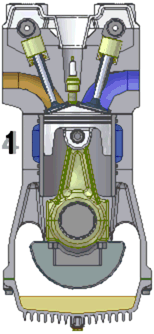LP Gas (propane) Fuel Injection for Single Cylinder Engines

This is a finished project and comes with details of hardware, software and simple Arduino based electronics to convert a single cylinder 4 stroke engine to a gas fuel injection system.Video of the initial trials on a venerable Briggs and Stratton engine in a unique mobile laboratory are available at: http://www.youtube.com/watch?v=OlSgLCq8Bj0
This is a finished project and comes with details of hardware, software and simple Arduino based electronics to convert a single cylinder 4 stroke engine to a gas fuel injection system.
Video of the initial trials on a venerable Briggs and Stratton engine in a unique mobile laboratory are available at: http://www.youtube.com/watch?v=OlSgLCq8Bj0
NEW:
There is now a short video of the fuel injection solenoid being taken for a bit of a rev on the laboratory bench at http://youtu.be/gZE3INxaiw4
This project is ready to roll, so if you want to see it in print, just vote for it and it will come!
The original inspiration for this project was the desire to live a good life far from the electricity grid without bankrupting myself in the process or else living like someone from the dark ages. If you've ever done the maths for a solar energy system, you will find that you have the choice of designing for the winter months of low light and frequent rainfall, or else designing a system to suit the abundant sunlight of summer. Both will be a compromise, with the first requiring huge quantities of solar panels and batteries that will overflow with energy in the summer and the second being cheap and small but running out of steam in as soon as the days get shorter.
The usual practice is to build a system somewhere in the middle, and add a small generator to fill in the gaps. That is where this project takes up. Most backup generators used in Australia are single cylinder petrol units with no emission control and only a rudimentary carburetor; it would be hard to think of a worse system and so I decided that the first order of business would be to convert the engine to run on something cleaner and more sustainable.
Ethanol was a prime contender as there is a lot of sugar growing near where we live and I could 'roll my own', but doing the job properly would require some major engine modifications. Not impossible or difficult, but time consuming.
A bit more research unearthed LP gas (propane) or natural gas (CNG, methane) as options that would require no significant engine mods. CNG is perhaps the best bet as it has four desirable H atoms for every C, but CNG is not readily available and is quite expensive in bottled form. LP gas is cheap and readily available, and still has a good number of H atoms for every C so it was decided to start with LPG and then start work towards building a methane digester to produce my own natural gas.
The result is an LP gas fuel injection system that runs on an Arduino Uno and has the following particulars:
1. Prototype constructed on a Freetronics shield.
2. Fueling calculations performed using the speed - density plus volumetric efficiency (VE).
3. Manifold absolute pressure measured using an industry standard MAP sensor.
4. Crankshaft sensor using a Hall Effect device.
5. LP gas (propane) fuel using a Chinese gas injection solenoid (US$20!).
6. Pulse width modulation of the injector using an interrupt service routine on Timer1.
7. Mathematical derivation of the operating parameters included in the article, plus a simple Arduino sketch.
Putting it all together and standing back, all of the engines converted run spectacularly well and the system allows for very fine tuning of engine parameters.
Factory built engines in all conceivable applications have used and are still using the speed - density plus VE system, and so with a bit of tuning and dynomometer time, the system can easily be fitted into other applications such as karting, robotic aircraft or boating. There is furthermore a great deal of information and expertise available to help the budding experimenter as travel through this fascinating field.



Diskussion (1 Kommentar)